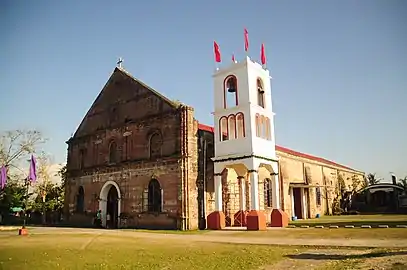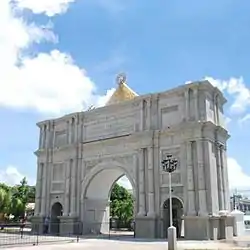St. Anthony of Padua Parish Church (Camaligan)
The St. Anthony of Padua Parish Church (Spanish: Iglesia Parroquial de San Antonio de Padua), originally known as Camaligan Church, is a Roman Catholic church in Camaligan, Camarines Sur, Philippines. It is the one of the two parish churches of the Roman Catholic Archdiocese of Caceres located in the town of Camaligan.[3] The parish was established in 1795.[1] The first church structure of Camaligan that was made of stones and woods was burnt in the year 1856.[2] The current church architecture was only completed in 1857,[4] a year after the original structure was burnt. Though, it is still considered as one of the oldest churches in Camarines Sur that is very rich in religious and cultural history,[5] and a popular spot for Visita Iglesia.[4]
| St. Anthony of Padua Parish Church | |
|---|---|
| Simbahan kan Parokya ni San Antonio de Padua Iglesia Parroquial de San Antonio de Padua | |
 Façade of St. Anthony of Padua Parish | |
.svg.png.webp) St. Anthony of Padua Parish Church Location in the Philippines | |
| 13°37′15″N 123°10′08″E | |
| Location | Camaligan, Camarines Sur |
| Country | Philippines |
| Denomination | Roman Catholic |
| Website | |
| History | |
| Status | Parish church |
| Founded | 1795 |
| Founder(s) | Franciscan Mission[1] |
| Dedication | St. Anthony of Padua |
| Architecture | |
| Functional status | Active |
| Architectural type | Church building |
| Style | Baroque |
| Years built | 1856-1857[2] |
| Completed | 1857[2] |
| Closed | N/A |
| Demolished | N/A |
| Specifications | |
| Materials | Stones, cement, egg whites, bricks made from ashes of freshwater clams, straws and clay [1] |
| Administration | |
| Archdiocese | Cacares |
| Province | Caceres |
| Clergy | |
| Archbishop | Most Rev. Rolando Joven Tria Tirona, O.C.D., D.D. |
| Rector | Rev. Fr. Glenn C. Ruiz, SThL, M.A |
| Vicar(s) | Rev. Fr. Serafin Amaro |
The church is under the Vicariate of St. John the Evangelist.[6] As of June 18, 2018, the current parish priest is Rev. Fr. Glenn C. Ruiz.[7]
History
Camaligan was under the ecclesiastical and civil jurisdiction of Nueva Caceres (now Naga City) for almost two centuries, from year 1578 to 1775.[1]
In the year 1775, the town became an independent political unit under the administration of Bishop Domingo Ollantes of Nueva Caceres.[8] However, it was only in 1795 when Fray Rafael Benevente, was appointed parish priest by the Franciscan mission.[9]
A church made of stones and wooden structures was built, but was burnt in the year 1856.[2]
A year after the burning of the original church, in 1857, during the term of Fray Juan Ontiveros as parish priest,[2] the present church structure was completed.[1] It is said that when this church was built, the real intention of the friars was to wipe out pre-colonial lifestyle and practices of the newly-colonized town from looking back to their pre-colonial lifestyle and practices. In fact, the land where the church stands is a former burial ground during pre-colonial times.[5]
Gallery
 The altar of the church
The altar of the church The church's bricks in detail
The church's bricks in detail The church with its newly-constructed belfry
The church with its newly-constructed belfry
References
- Escandor, Juan Jr."157-yr-old church endures in Camarines Sur". Inquirer.net. 17 April 2014. Retrieved June 13, 2019.
- Marcaida, Dominador Jr. "Profile of Barangay San Mateo, Camaligan, Camarines Sur". Escuela Catekumenal Communities. 27 April 2014. Retrieved June 14, 2019.
- "Parish Directory of the Archdiocese of Caceres". Archdiocese of Caceres. 10 March 2018. Retrieved 13 June 2019.
- "VISITA IGLESIA IN CAMARINES SUR, PHILIPPINES – 7 CHURCH IN 7 DAYS ITINERARY". Two Monkeys Travel. 2 February 2019. Retrieved 13 June 2019.
- "Historic Camaligan". I Know Places. 30 March 2019. Retrieved June 16, 2019.
- "List of Vicariates". Archdiocese of Caceres. 10 October 2018. Retrieved 13 June 2019.
- "New Assignments of Priests in Caceres". Archdiocese of Caceres. 29 March 2018. Retrieved 13 June 2019.
- "Origin of the Name of Camaligan". camaligueno ako. 6 February 2011. Retrieved 13 June 2019.
- Marcaida, Dominador Jr. "Camaligan Town and Municipality History". Academia. 30 September 2016. Retrieved June 16, 2019.
External links
| Wikimedia Commons has media related to St. Anthony of Padua Parish Church (Camaligan). |
